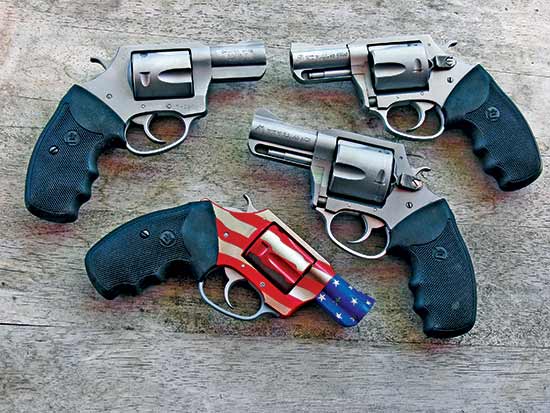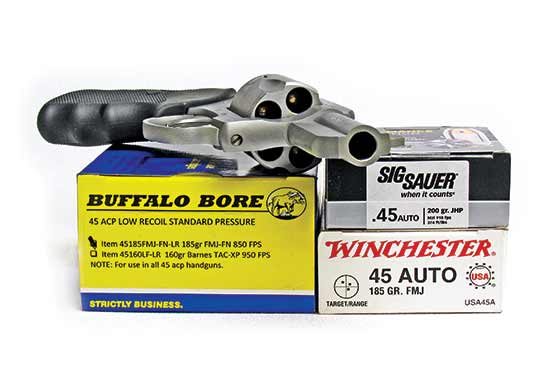Charter Arms' New "Auto" Cartridge Revolvers
9mm/.40 S&W And .45 ACP+ Old Glory In .38!
Charter Arms has been going to the dogs for over half a century. In the mid-1960’s Charter Arms combined dogs and the .44 Special when they brought out the first .44 Special Bulldog. It could not have come at a better time. Charter Arms with their .44 Special managed to keep the meagerly flickering flame of the Special alive at a time when both Colt and Smith & Wesson dropped their .44 Special sixguns.
The Charter Arms original .44 Special was a blued 5-shooter with a 3″ barrel. At the time it was one of my most-carried sixguns and logged many miles in the top of my boot. It went on fishing trips, hiking trips and family outings. One year, now nearly 40 years ago, we rented a motorhome and took a rare vacation with the kids who were all in high school at the time, and the .44 Bulldog was stashed in the camper. Twice in my life I feel having a gun along served to protect my family. In both cases the gun I had with me at the time was the .44 Bulldog.
Two of my house guns are .44 Bulldogs, with a stainless steel version stashed in each of the bathrooms. Can you think of any place you would be more vulnerable in the house than a bathroom? If something happens I want a gun immediately and easily at hand. In the bathrooms the stainless steel Bulldogs are always ready-loaded with 200-grain Blazer JHP’s. The first time I mentioned this in writing several years ago, some laughed. Many others felt it was a most sensible idea and followed suit. I hear from people all over the country who now have stainless steel handguns stashed in their bathrooms. The .44 Bulldog is perfect for such duty.
I’ve spent much of my gun-writing life talking about big bore sixguns in general and quite often specifically focusing on the .44 Special. However, I have rarely mentioned the Charter Arms .44 Special Bull Dog. It has been part of our family for a long time, however it’s rarely ever seen or even shot — simply always at hand.
Newer Models
The Second Generation of Charter Arms Dogs is the Pug. The Pug is the same basic design as the two original Bulldogs (blued and stainless versions) however there are differences. The barrel length is now 21/2″ and the ejector rod enclosed. The grip design has also been changed and the Pug is fitted with finger groove rubber grips that are quite narrow, very comfortable for shooting, and also mate well with the satin matte stainless steel finish. The sights are a very-easy-to-see square rear notch matched up with a ramp-style front sight rather than the post of the originals. The Pug shoots closer to point of aim than my original Bulldogs and is quite accurate.
Now we are at the Third Generation of Charter Arms Dogs with the Pit Bulls. The Charter Arms Dogs followed a natural evolutionary path. First came the blued Bulldog, then shortly thereafter the stainless steel version. These standard Bulldogs are no more though, with the “new breed” taking over.
And now, Charter Arms has come up with a way to fire rimless semi-automatic cartridges in a revolver without having to use moon clips. The first chamberings offered were in 9mm and .40 S&W, and the latest is now the biggest dog of all — the .45 ACP Pit Bull.
Charter Arms says of this Pocket Powerhouse: “The unique design provides a dual coil spring assembly located in the extractor allowing for the insertion and retention of the .45 ACP caliber cartridge in each chamber of the revolver’s cylinder (no moon clips required). This patented system allows the shooter ease of ejecting spent cartridges for immediate reloading. Charter Arms has taken the difficulty of rimless loading and ejection to the simplicity of the rimmed cartridge in the revolver industry.”
Normally sixguns using any of these three semi-auto rounds need clips, whether they be half- or full-moon, to aid in ejection. The clip gives something for the ejector star to contact allowing the cartridges to be easily ejected. Some even require the moon clips for consistent ignition. With the Charter Arms Pit Bull, moon clips are simply not necessary, nor would they fit, as the small finger protruding from the five stations of the ejector star snap into the ejector cut just above the rim of a semi-auto cartridge.
Loading Tips
When loading the Pit Bull cartridges do not simply drop them in. They must be worked past the spring-loaded finger in each cut-out in the extractor star. This requires a little effort and a short learning curve to do this. The entire case body, including the mouth of the cartridge case, must make it past this finger to allow cartridges to fully enter the chamber. The first attempt seems quite clumsy and awkward, however with repetition comes ease of operation. As with all double-action revolvers it’s recommended the revolver be pointed straight up as the ejector rod is tapped to eject the empties. This needs to be a positive operation to ensure empties are all ejected.
The Charter Arms Pit Bulls, be they .45 ACP, .40 S&W or 9mm, are all stainless steel, with well thought out finger-grooved neoprene grips aiding in comfort and controllability. Frankly, I was surprised at the lack of punishing recoil. All of the loads tried had minimal felt recoil, even the .45 ACP. Charter Arms recommends against the use of +P loads and I myself have no desire to use them in such a small sixgun. Nor do we need them with all the grand choices we now have in carry ammunition.
Barrel length is 21/2″ for the .45 ACP, 2.3″ for the .40 and 2.2″ for the 9mm. All have fixed sights consisting of a square notch rear cut into the top of the frame and a serrated ramp front sight which is an integral part of the barrel. The sights are big and broad and quite easy to pick up. For me each of these Pit Bulls shoot low and require filing the front sight to match the load selected for everyday use. The front of the trigger is smooth and provides a single-action pull of about 5 pounds but it seems lighter. The double-action pull is also quite smooth.
Can They Shoot?
Since this is basically a big-bore sixgun designed for self-defense use, test-firing was done at the across-the-room distance of seven yards. For the .45 ACP six factory loads were used in testing and I was surprised at two things, actually three. The mild recoil, the accuracy and the relatively decent velocities from such a short barrel were all pleasant surprises. Three loads grouped four shots into 1″ at seven yards — the Winchester 185-gr. FMJ load clocking out at 777 fps, SIG SAUER’s 200-gr. JHP at 828 fps and the Buffalo Bore Low Recoil 185-gr. FMJ at 662 fps. The latter load is perfect for anyone bothered by recoil, and the SIG SAUER load at nearly 830 fps is quite respectable out of such a small, 5-shot revolver.
With the 9mm Pit Bull, it’s simply more of the same. SIG SAUER’s 115-gr. JHP grouped into 11/8″ clocked out at just under 1,100 fps. Technical Ammunition’s 124-gr. Lead Free HP shot the same size group at 1,075 fps, and the HPR at the same speed puts four shots into 13/8″ at the same seven yards.
The .40 Pit Bull is the same song, third verse, as it shot 11/4″ groups with the American Eagle 165-gr. FMJ at 915 fps and the Buffalo Bore Hard Cast Flat Nose at 935 fps. Both of these are definitely Power-Packed loads for the Pit Bull.
Any of these Pit Bulls using semi-auto cartridges would be an outstanding backup gun to a like-chambered semi-auto pistol. As far as this goes, any one of them would make an excellent carry gun, especially when you consider all the potent loadings available today for self-defense use. Just as with most (all?) double-action revolvers offered today, the Pit Bulls would benefit from an action job done by an expert sixgunsmith.
And A .38
Charter Arms has not stopped with the Pit Bull. Their first Pocket Pistol more than 50 years ago was the .38 Undercover. This 5-shot .38 has found its way into thousands upon thousands of pockets and purses over the decades. It has been offered in blue and stainless versions and now several Cerakoted .38’s are available.
The latest is “Old Glory” and it’s fitting I spent Memorial Day morning shooting this patriotically adorned .38 Special. It has the same recoil absorbing grips as the Pit Bull’s and it’s also stainless steel. However, it gets its name from the fact it’s finished in patriotic colors. The frame is red striped and the barrel is blue with silver stars. This little J-Frame-sized .38 shoots exceptionally well considering its small size and 2″ barrel. With all the semi-auto pistols developed and made available the past three decades the .38 Special snubbie is still an excellent choice. For new shooters, probably the best choice, as they are simplicity itself with nothing to do but pull the trigger.
I tried five different factory loads in “Old Glory” and all performed exceptionally well. Two of these loads used cast full wadcutter bullets. Buffalo Bore’s 150-gr. WC clocked out at 850 fps with a group of 13/8″ while their 158-gr. LSWC HP at the same speed grouped its four shots in 11/4″. Both of these loads are standard pressure loads making this exceptional performance from a 2″ barrel.
The other full wadcutter load is the milder Winchester classic target loading that clocks out at 610 fps with its 148-gr. target wadcutter bullet. Not surprising it was also exceptionally accurate with a 1″ group. Two of Hornady’s self-defense loads are also worth looking at for use in this pistol. Their 125-gr. XTP-JHP clocked out at just under 800 fps with a 1″ group while their 158-gr. version of the same bullet at 665 fps turned out to be the most accurate load through any of these four Charter Arms Pocket Pistols, with a 3/4″ group for four shots!
Charter Arms has been supplying self-defense pistols at reasonable prices for 5+ decades now. All of these are definitely welcome additions. Can you say “Great value for your money?”
Heavy Duty Dogs
That first blued revolver also had beautifully designed walnut stocks that completely enclosed the grip frame without being large or bulky, and very easy to see square-fixed sights. The ejector rod was not enclosed nor did it latch at the front in the conventional way. Instead the cylinder locked at the rear and also at the front of the frame. With its 5-shot cylinder and bolt slots cut between chambers, the Bulldog is much stronger than it appears. In fact it will probably handle heavier loads than most of us would care to shoot.
My normal heaviest load for the Bulldog is the Keith 250-grain SWC over 7.5 grains of Unique. This load is definitely sufficiently powerful, however, I rely on factory loads for defense.










